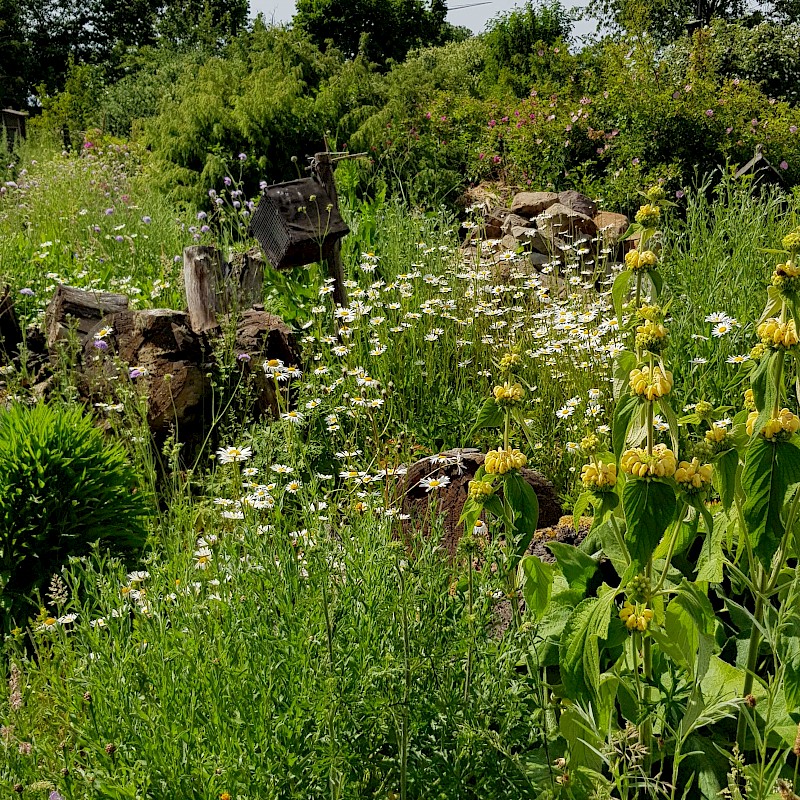An interview with NABU Münster's Nature Garden AG
A natural garden not only looks beautiful and attracts many animals - it also requires little effort! What other advantages a natural garden brings, whether there is a typical Münsterland natural garden and how I can promote biodiversity and liveliness in my garden - the Naturgarten AG of NABU Münster has answers to all these questions. In the interview, she assures us: "A natural garden hardly takes any time, because people intervene less to regulate it. Little weeding, pruning, watering...so there is time to enjoy!"
What is a nature garden?

© Münsterland e.V.
A natural garden consists largely of native wild plants. You can introduce them deliberately or let them establish themselves and then weed out the interfering ones. Those who know the plants have an advantage here: what grows tenderly and what is rampant? Weeding is allowed. A natural garden is not a wilderness, but a near-natural design:
Plants grow in places that suit them well (soil type, temperature, light, precipitation) and enrich the garden with structures. For example, plant stems are left standing and woody plants are allowed to retain their natural shape to a large extent, so that they provide food and nesting space. The garden develops dynamically, because with seeds, runners and the like, plants tend to "wander".
In addition, as little plastic as possible is used in a natural garden. Poison is taboo, as are synthetic chemical fertilisers; instead, plant soaks and compost are used. Soil should not contain peat, because the degradation of peatlands releases massive amounts of greenhouse gases and destroys valuable habitats. A natural garden thus protects the environment and is home to many native wild plants and animals.
What are the advantages of a natural garden?

© Münsterland e.V.
Native wild plants are adapted to our climate and soils. In a near-natural association, they therefore survive drought or heavy rain better than exotics. In addition, they flower throughout the year and - in their wild form - are adapted to the animal kingdom. Structures such as fruiting hedges or shrub stems with seeds in autumn nourish and shelter crawlers, mammals and birds. Avoiding poisons is also good for your own health.
The best thing about a natural garden is that it hardly takes any time at all, because people are less inclined to regulate it. Little weeding, pruning, watering ... so there is time to enjoy!
What is typical of a "Münsterland nature garden"?
The Münsterland is rural, the inhabitants love their green surroundings and like to explore their parkland by bike. There is no standard template for nature gardens; personal preferences determine the design and the "wilderness degree" of one's own garden.
It is to be hoped that many Münsterlanders will remember the flowering meadows and fields of their childhood. Of frog ponds, interwoven hedges and avenues of fruit trees. And that they would like to preserve some of this diversity in their gardens.
How do I turn my garden into a natural garden? What do I have to consider?
In the meantime, there are specialist companies that have specialised in the planning and creation of natural gardens. Elaborate elements such as ponds with a marshy zone or dry stone walls can be realised wonderfully and new habitats can be created. However, small steps alsocount: simply let part of the lawn grow, create grass-free areas and sow or plant with wildflowers, or wait and see which plants take over of their own accord.
Thecreative design ideas are unlimited, with pleasure with existing materials such as: piled up demolition stones or bricks, tree roots, branches, twigs gathered into heaps. Add to this a water bowl, holes drilled in old poles for wild bees, a first herb bed, a few strawberry plants for snacking, a currant bush....
Note that the existing nature is valued: are there already ground-dwelling bees? Do I have to dig here? How many insects do flowering dandelions feed?
By enjoying gardening and being mindful of plants and animals, everyone can gradually increase the biodiversity and liveliness of their garden.
Let yourself be inspired!
The AG Naturgarten at NABU Münster has been in existence since the end of September 2020. The central guiding principles of the AG Naturgarten are based on the intention to counteract the striking decline in biological diversity. In order to counteract this dramatic development, the AG Naturgarten has therefore set itself the goal of promoting the near-natural design of gardens and green spaces in Münster. Only appropriately designed and sustainably managed gardens and green spaces can fulfil ecological functions as so-called stepping stone biotopes in the biotope network, enabling plants and animals to spread again in the settlement area.
Interest aroused?
NABU-AG-Naturgarten@web.de
www.nabu-muenster.de/ag-naturgarten







